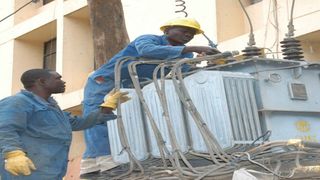
Kenya Power technicians repairing a transformer along Kenyatta Lane in Nakuru City in 2021.
| File | Nation Media GroupWeekly Review
Premium
Inside the shady deals that control Kenya Power
Kenya Power staff are beneficiaries of one of the most expensive power producers that sells electricity to the utility firm, reaping billions of shillings annually as Kenyans struggle with high power prices.
Their participation is through part ownership of the Gulf Power Limited (Ltd), an Independent Power Producer (IPP), with a contract to supply Kenya Power with electricity up to 2034.
Last year, the company was paid Sh3.569 billion for supplying 81 million units of power at an average rate of Sh44.07 per unit, an audit shows. It was 4.5 times the average rate of electricity by all suppliers in 2022, and more than seven times that of Kenya Electricity Generating Company (KenGen).
This was the third most expensive electricity supplied last year, after the 69 million units by Triumph Power Generating Company Ltd at an average rate of Sh58.86 per unit, and 71 million units by Off Grid Power Stations at Sh53.13 per unit.
Interestingly, Gulf Power was registered in 2009, just when Kenya Power was tendering to procure electricity from IPPs, and emerged among the first three that were contracted in 2012.
While ownership of the three firms is shrouded in mystery, with records on shareholding of Off Grid Power Stations lacking at the Business Registration Service (BRS), Gulf Power is interestingly owned by two associations attached to current and former staff of the utility firm, together with a company registered in Mauritius – a tax haven.
Part of Gulf Power shareholders include The Kenya Power and Lighting Company Limited Staff Retirement Benefits Scheme 2006 and the Kenya Power and Lighting Company Limited Staff Retirement Benefits Scheme, each holding five shares.
Also, among the six directors of the company is Mr Ernest Nadome, the Secretary-General of the Kenya Electrical Traders and Allied Workers Union (Ketawu), which represents Kenya Power workers. Kenya Power maintains that it cannot be blamed for its staff owning shares in the IPP, the retirement schemes being different entities from the firm.
The contract with Gulf Power was signed in December 2012 and became effective in 2014, to run until 2034. Then just a year later, in 2015, the pension funds purchased shares at the IPP, to collectively own 10 per cent of the company. “The pension funds are separate entities from KPLC.
The shares were bought in 2015 through a 10 percent equity stake,” a source at Kenya Power told The Weekly Review. He maintained that the funds purchase of shares at Gulf Power was independent, investment-based decision, rather than a case of conflict of interest or designed to be that way when the contract was entered.
“You will find most of these plants have international pension funds, it should even be nice that our pension fund is thinking of investing within the country. The way the Power Purchase Agreements (PPAs) are structured across is that Kenya Power’s right to interfere with any changes in shareholding is with regard to assignments. If Gulf wanted to assign its functions to another plant or another owner, we would then have a right to be given a chance to refuse. But changes in shareholding isn’t an issue KPLC engages in as per the PPA,” another source said.
Gallant Power, a company registered in Mauritius, holds 80 shares at Gulf Power and Noora Power Limited has 10 shares.
During a parliamentary sitting probing energy cost in the country in April, senators alleged that former Kenya Power Managing Director and former PS Joseph Njoroge is among shareholders of Gallant Power.
Capacity payments
“Upon making the decision to invest, the fund is required to appoint an individual to oversight the interests of the fund in that board. So Ernest Nadome is there by virtue of being a Trustee of the pension fund,” a source told The Weekly Review. Other directors of Gulf Power are Suleiman Shahbal, Philip William Dyk, Victoria Cherotich, Ahmed Said Bajaber, Duncan King’ori Mukira and Francis Koome Njogu.
The utility firm acknowledges that much of what Gulf Power is paid is not for supplying electricity, but rather capacity payments, which are paid for whether or not the IPP has delivered.
Gulf Power was contracted to supply 598 million units of power annually, ideally being 85 per cent of its capacity of 703.6 million units to allow for times when the plant is under maintenance. But last year, it supplied a mere 81 million units (13.5 percent of the expected supply).
The less the firm is utilised, the more Kenya Power spends on it for doing nothing, as the utility firm, through Kenyans who pay high electricity costs absorb its maintenance costs, paying its workers’ salaries, debts to its financiers and paying its owners.
“The issue of conflict of interest appears remote when you look at it in the sense that to run a dispatch from the company we have the national control centre and a system used to tell power demands and supply. From where I sit, it would be difficult to say that those individuals (KPLC staff) sitting there (at the control centre) just sit down and say ‘let’s allocate work to Gulf because we have long-term interests in Gulf,” a source at Kenya Power said.
Gulf was contracted on a take-or-pay pricing mechanism, which means that whether it is working or not, Kenya Power has to make some fixed payments to settle issues such as debts used to finance construction, staff salaries, insurance and owners of the company.
Meanwhile, Kenyans continue to suffer high electricity prices across domestic and commercial uses, with latest data from the Kenya National Bureau of Statistics (KNBS) showing that electricity prices have risen by up to 69 per cent in just a year. In August, 50 kwh of electricity- mainly used by low electricity users such as households- cost Sh1,344, from Sh796.83 during a similar month last year.





